The Diminishing Returns of Heroic Materialism 2: End of the Line
December 4, 2011
We’ve been talking about the Diminishing Returns of Heroic Materialism:
October 30, 2011: The Diminishing Returns of Heroic Materialism
This follows some of our other comments on Heroic Materialism, one name for the age we live in today:
November 22, 2009: What Comes After Heroic Materialism?
November 8, 2009: The Future Stinks
What we are trying to do is to identify and name certain repetitive thought processes, which constitute the character of the Heroic Materialist age. What we find is that these thought processes used to bring great results. Then, after a while, their results were not so great, but they were still positive. However, today, applying these same thought processes actually makes things worse. We want to identify different thought processes, which can bring huge results to us today, much like the original Heroic Materialist thought processes brought huge results in the 1780-1960 period. If we implement these different thought processes, we will, in effect, begin a new age of civilization.
I have argued that these new thought processes are blatantly obvious to anyone who stops to think about them. Mostly, they involve our daily life. Things like City Design — making a pleasant place to live. We used to be very good at this. We have extraordinary successes in City Design, throughout Europe, Asia, and even in the Americas, mostly south of Texas.
November 6, 2011: Let’s Take a Traditional City Break 5: Stuff That Works
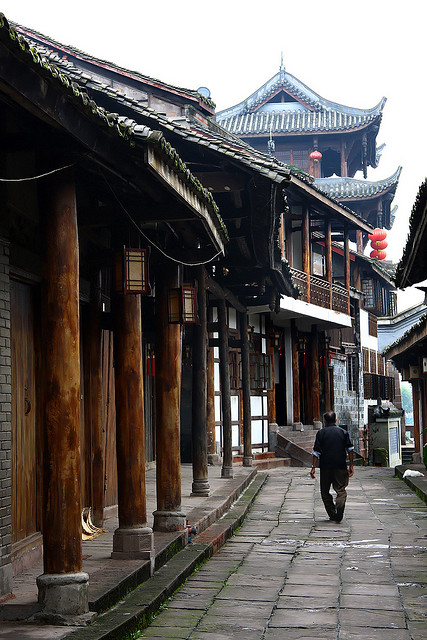
Does the place you live look as good as this?
Why not?
(Huanglongxi, China)
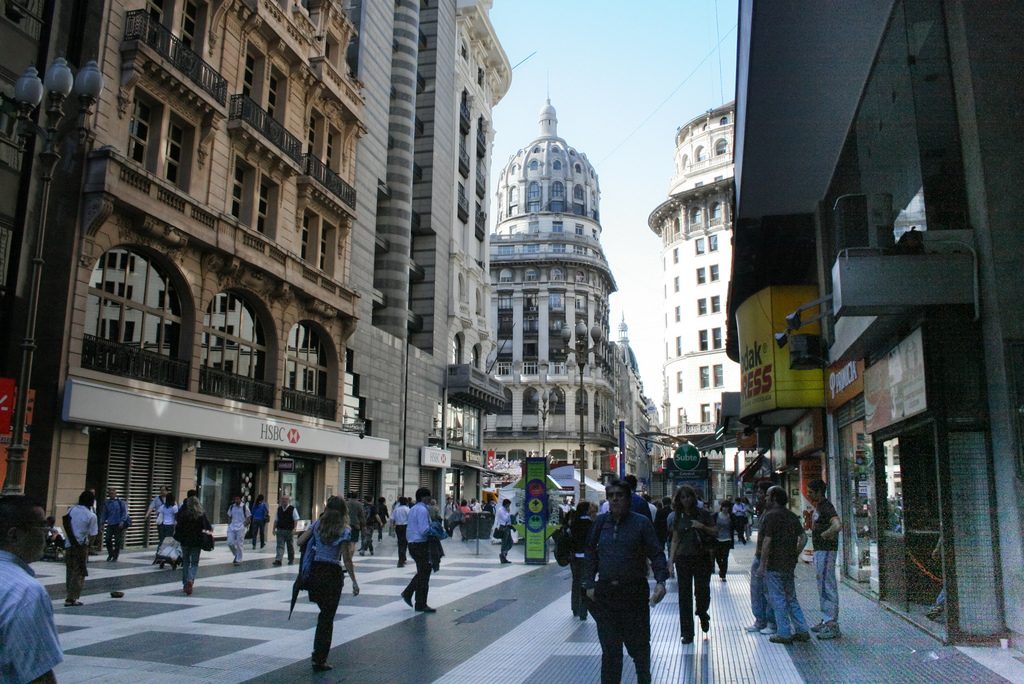
Does the place you work look as good as this?
Why not?
(Buenos Aires, Argentina)
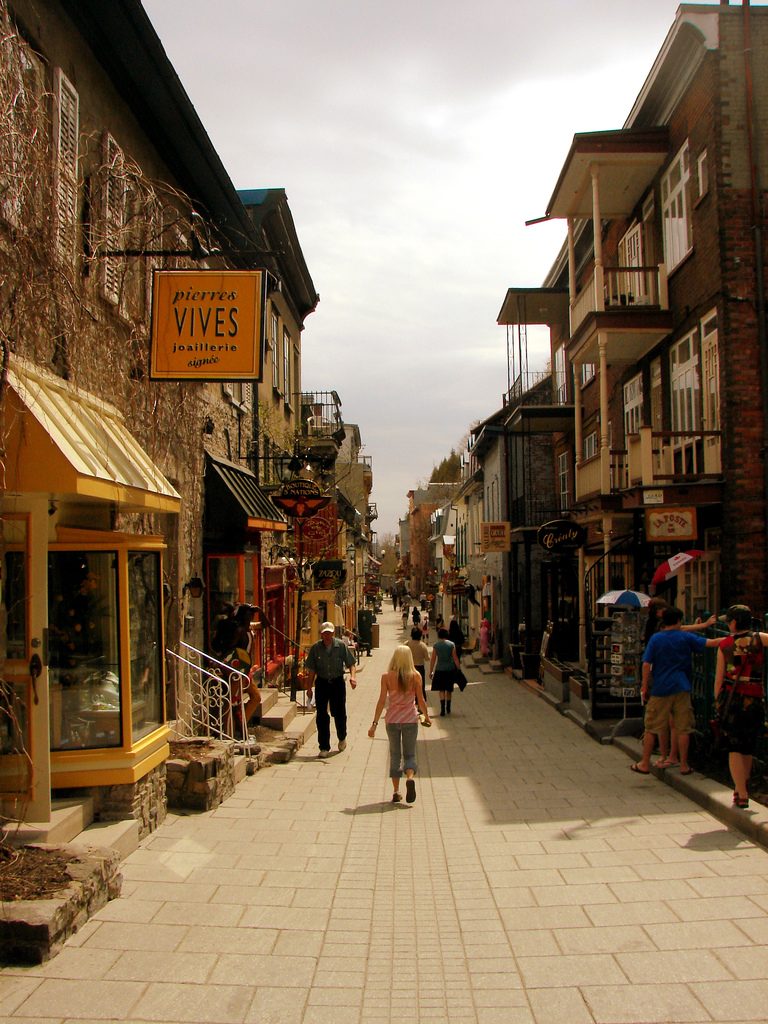
Does the place you shop look as good as this?
Why not?
(Quebec City, Canada.)
It involves a greater sense of aesthetics throughout our lifestyles. Things such as the clothes we wear:
July 3, 2011: The New World Economics Guide to Men’s Fashion
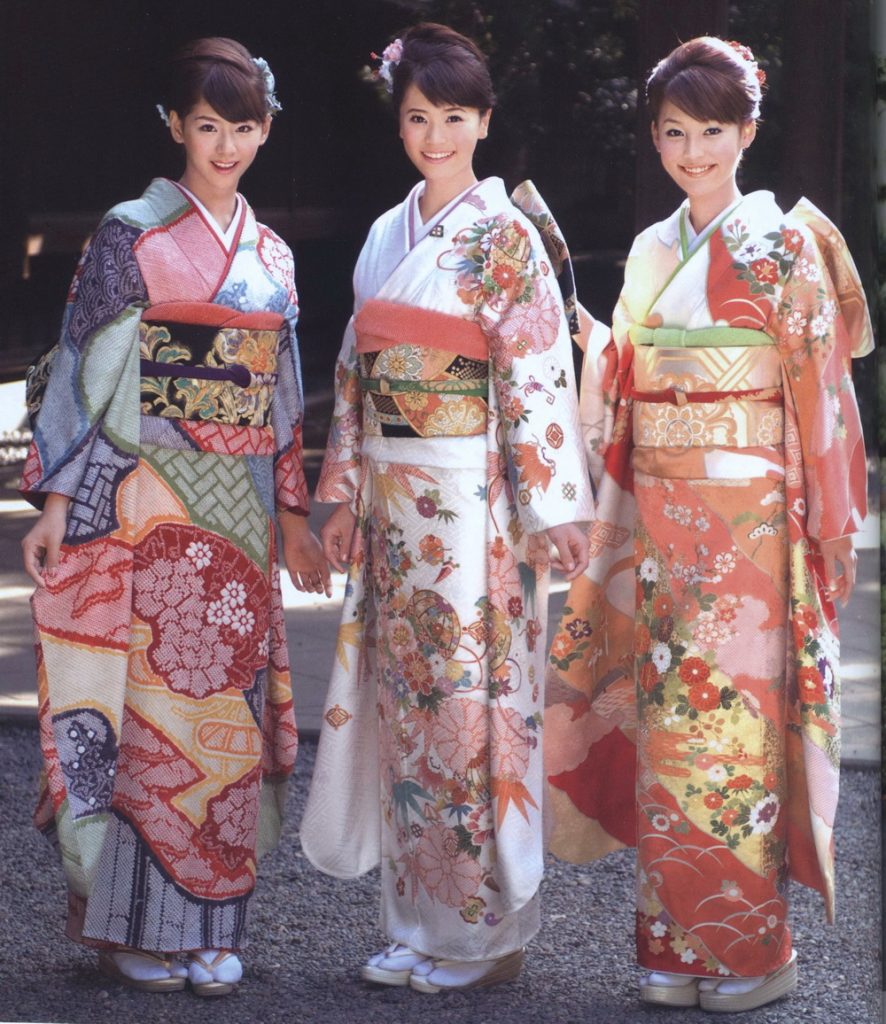
Have you ever, even once, worn something this fantastic?
Why not?
We used to do this, you know.
It can involve economic policy, what I call “21st Century Capitalism.”
January 12, 2011: Moving Toward 21st Century Capitalism
It can involve our diet and exercise. If we paid as much attention to the quality of our food as we pay to our cars, what kind of food would we eat?
Map charting the “obesity epidemic” in the United States from 1995-2008.
Let me give you a little hint: we weren’t all that healthy in 1995 either. But compared to today, it seems like a Golden Age!
What if we just went back to the quality of food we had in 1900? Now, I’m not saying that the typical American diet of 1900 was all that great. However, it was all organic, all natural, had no processed foods, no junk food, no “fast food,” no hormones and antibiotics, no MSG, and no high-fructose corn syrup.
Eat food. Not too much. Mostly plants.
I’m trying to point out, during our insane focus on Heroic Materialism, all the things we have been neglecting.
But back to Heroic Materialism. Let’s try to identify these repetitive thought patterns, which brought great advances in the past, but are now killing us.
Motorization and Fossil Fuels. The Industrial Revolution dates, in large part, from the invention and implementation of the steam engine. The original steam engines burned wood, but before too long they were burning coal. Later, we developed internal combustion engines that burned diesel and gasoline.
These allowed the mechanization of all sorts of things, beginning with textiles. But, mostly, it meant much easier transportation, by steam train, and steam ship, and later by truck. We could eliminate the horse-drawn wagon. It’s hard to imagine, today, how hard it used to be to move things overland. A horse-drawn wagon can move about 20 miles a day. So, if you want to go 150 miles, that would take ten days. And then, it would take ten days to get back. On dirt roads. And, you would have to feed and maintain the horse. Do you have any idea how much those things eat? And poop? Even with all that, you couldn’t carry more than 1000 lbs or so, maybe less.
But, today, we are about done with this — in a sense, anyway. We’ve taken the “automobile” idea about as far as it should be taken. Indeed, the way forward for us is to reduce our automobile use. Ideally, eliminate them for most people. This is done by introducing proper City Design, and the use of trains. Yes, you can still use trucks to carry heavy things, but moving people should be done mostly by trains, buses, and the occasional taxi.
With the elimination of personal automobiles for most people, our lives would become a lot less mechanical. We wouldn’t be owners and maintainers of huge pieces of machinery.
As a result, we could use a lot less fossil fuels.
Mass Production. Before the Heroic Materialist age, most everything was handmade. Clothes were tailored. Shoes were made by a “cobbler.” Mass production enabled the creation of much larger quantities of goods at much lower prices. This was fine, but what do we have now. For most people in the developed world, we have “way too much crap.” First, there is too much of it. We all struggle to simplify, declutter and reduce — mostly unsuccessfully. We admire those houses that don’t have a ton of junk lying everywhere. Second, it is crap. Look at your stuff. Is any of it heirloom quality? Even one single thing? Although people in the past didn’t have nearly as much stuff as we have today, it tended to be of very high quality. Even more recent times, I think of the 1920s-era furniture that I find in antique stores around here. It is of very good quality — beautiful Art Deco styling, beautiful crasftmanship, all solid wood. No Ikea fiberboard crap. And, it is small. The typical 1920s armoire has room for about three suits, and eight shirts. That’s it. I think we should return to something more like that. To have just what we need, but it should be beautifully crafted. It’s OK if it costs 5x as much, because we have 10x less of it.
I would like to see the return of a lot more personal craftsmanship — the way people made things before mass production. This still exists, of course, but people are so into their habits of “mass production” that they can’t even imagine actually buying and owning such a thing.
It doesn’t have to be expensive. You can get a custom-tailored suit for less than an off-the-rack designer brand. You can get handmade pottery for less than the factory-made crap at Pottery Barn. And, even if it does cost more, then just spend the money. Japan still has a wonderful tradition of handmade pottery. Not just that people make it — but also, more importantly, that people buy it. It is very common for a typical middle-class family to acquire, over a period of years, a collection of pottery that they use every day. This, of course, supports a community of artisan potters. There are excellent artisan potters in the U.S. too, but far fewer, because Americans don’t seem to imagine that you can own something handmade and beautiful rather than some factory crap.
So, I would like to see a lot more artisans, and alongside, a lot more people buying artisan-made goods rather than disposable factory-made stuff. And, buying a lot less of it, quantity-wise. We can still have mass production of light bulbs and toaster ovens.
Along with mass production came the aesthetic of mass production.
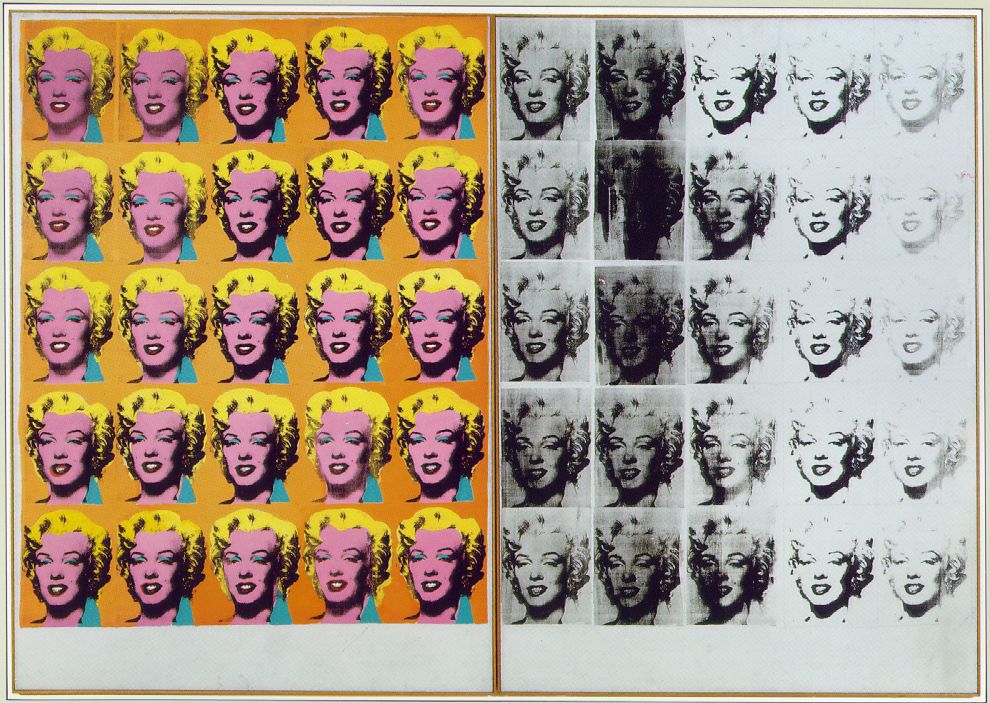
In those areas where we could express ourselves, show the world our creativity and artistry, instead we imitated a factory churning out clutch assemblies!
This was utterly destructive.

I think we should learn to leave mass production where it belongs, and bring back artistry and creativity where it belongs.
Civil Engineering. The Heroic Materialist Age has no cathedrals. Many very nice buildings were made during the 19th century, but 20th century architecture is mostly a wasteland. Instead, the great building projects of the Heroic Materialist Age were mostly in the field of civil engineering — things like bridges, dams, superhighways, and other great feats of concrete-pouring.
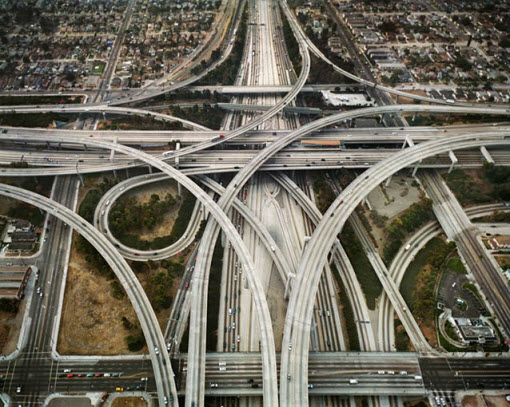
This is our Chartres Cathedral. It’s where we go in our automobiles to pay homage to the gods of Heroic Materialism.
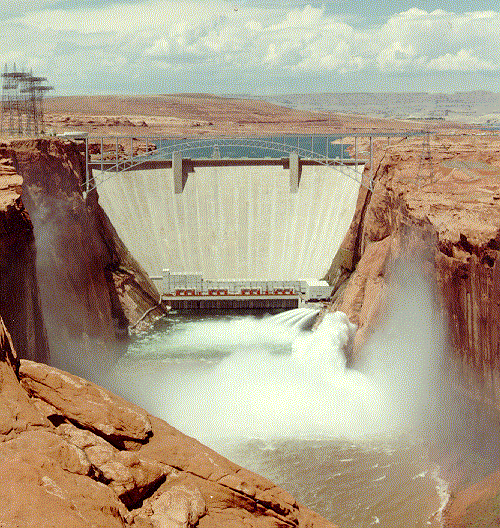
Our Sistine Chapel.
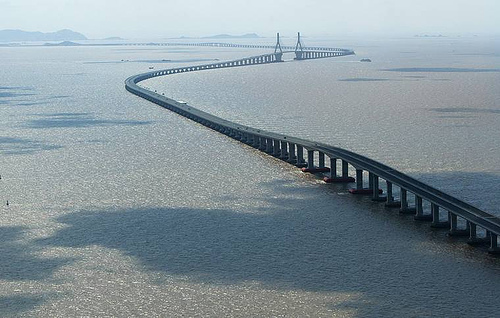
Our Duomo.
This is something that has pretty much fizzled out in the U.S. today, but it was once a central part of our Heroic Materialist dreams and ambitions. At first, it was a practical matter. It was a lot easier to get to Brooklyn once the bridge was built. Plus, it looked great too. After a while, it became a game of “can you top this”? Fortunately, we are done with this today, but it goes to show how our Heroic Materialist project is pretty much complete. The only arena where we are getting significant new improvements from Heroic Materialist behavior is with computers.
Skyscrapers: Before the Heroic Materialist age, it was really hard to make steel. You only used it for things like swords and other hand tools. With the advent of large-scale steel production, we also became able to make very tall buildings. This was fun!
Electricity: Can you imagine what a big step forward electricity was? However, again, this is something that is pretty much done. We aren’t making any great advancements in electrification. The biggest advancements recently have been along the lines of doing the same thing with less electricity, such as compact fluorescent lights. So, there are still some marginal improvements. But, nothing like the life-changing developments of the past. We might have a big leap forward ahead of us if solar panel production gets cheap enough to replace coal-fired electricity. This is possible. However, even then, it wouldn’t be a matter of providing new goods and services, but rather maintaining our existing goods and services (electric lights, refrigerators, computers) by a different means.
Computerization: As we’ve been documenting here, most aspects of Heroic Materialism are played out. We’re not making any great new advances in transportation, in construction, in concrete-pouring, in electrification. The one Heroic Materialist project which continues to produce meaningful advancements is in computerization. The Internet is only 15 years old, and look at what we’ve been able to do recently with things like cellphones, video games, etc. All of these things have had some negative effects — more time spent on the computer means less time doing other things — but, for the most part, the positives greatly outweigh the negatives.
I bring up computerization in part as a point of contrast — to see what it is like to have a sphere of activity that continues to bring meaningful improvements, to compare with these other Heroic Materialist activities which have gone way past that point, and are now well into the realm of diminishing returns.
Unfortunately, most people deal with the Diminishing Returns of Heroic Materialism with … more Heroic Materialism.
http://www.newyorker.com/reporting/2011/11/28/111128fa_fact_packer
These are the people who think that “biotech” will enable them to live to be 200, even though, as I have already noted, it is hard to name any advancements at all from “biotech” over the past twenty years. Good luck with that one. Will “biotech” cure your obesity-caused diabetes?
These people also want flying cars — I thought we are so over that but there are always some stragglers — and of course, a vacation house on Mars. They also have some sort of computer ambitions, of course super-high-tech like “uploading their brain into a computer” (whatever), apparently oblivious to the fact that what the Internet has achieved for us so far has been mostly low-tech in a sense, the ability to create and receive plain old words and pictures at no cost. (One reason I keep the $1.95 decor of this website is to demonstrate that all you really need is black text on a white background, and some pictures.)
But we can’t create it until we imagine it. I propose that — even as we continue to make advancements in computers and whatnot — we throw away the Jetsons image of the future, and instead adopt something that is a lot more interesting, a future that has all of the advancements of the Heroic Materialist age, but also recovers those wonderful parts of our human experience which have become atrophied nearly to the point of disappearance.
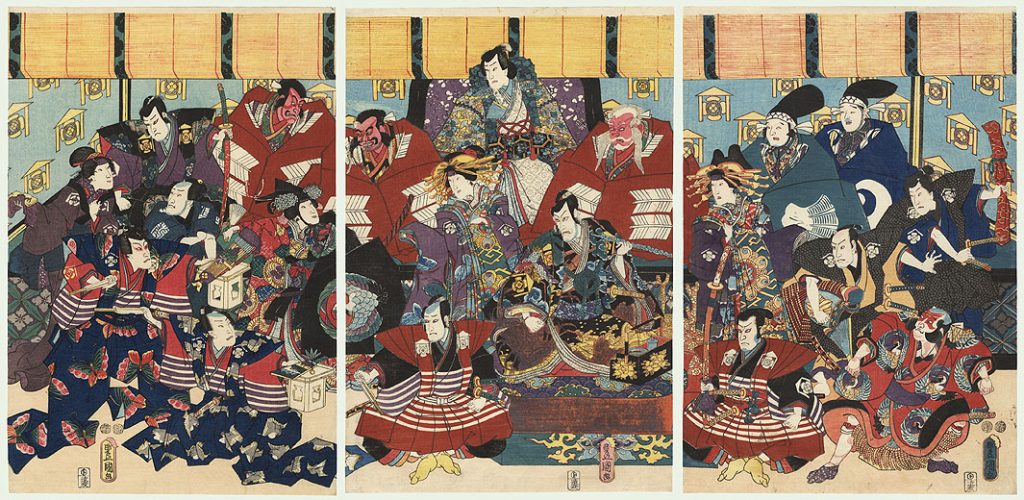
New Year’s celebration, 1840s.

Card game, 17th century.
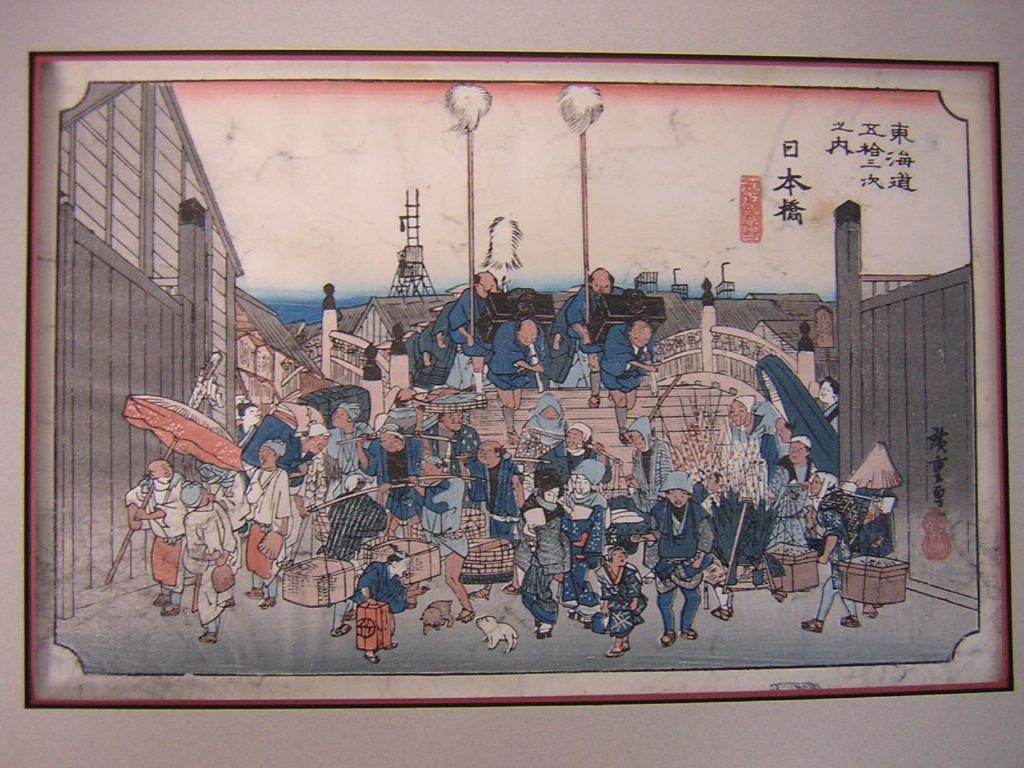
Traffic over Nihonbashi bridge, Tokyo, early 19th century.

Music lesson, 17th century.
Other commentary in this series:
November 6, 2011: Let’s Take a Traditional City Break 5: Stuff That Works
October 30, 2011: The Diminishing Returns of Heroic Materialism
September 25, 2011: Let’s Take a Traditional City Break 4: Many Variations, One Theme
August 21, 2011: How To Make A Pile of Dough With the Traditional City 6: Better Than a Thousand Words
July 31, 2011: How To Make a Pile of Dough With the Traditional City 5: The New New Suburbanism
July 17, 2011: How To Make A Pile of Dough With the Traditional City 4: More SFDR/SFAR Solutions
July 3, 2011: The New World Economics Guide to Men’s Fashion
June 12, 2011: How to Make a Pile of Dough with the Traditional City 3: Single Family Detached in the Traditional City Style
May 15, 2011: A Ski Resort Village
May 1, 2011: Let’s Take a Traditional City Break 3: Life With Really Narrow Streets
April 3, 2011: Let’s Take a Trip to the Skinniest House in New York
March 20, 2011: Let’s Take a Trip to Julianne Moore’s House
February 13, 2011: Let’s Take a Traditional City Break 2: More Really Narrow Streets Than You Can Shake a Stick At
February 6, 2011: Let’s Take a Traditional City Break
December 19, 2010: Life Without Cars: 2010 Edition
October 17, 2010: The Problem of Scarcity 3: Resource Scarcity
August 22, 2010: How to Make a Pile of Dough with the Traditional City
August 1, 2010: The Problem With Bicycles
June 6, 2010: Transitioning to the Traditional City 2: Pooh-poohing the Naysayers
May 23, 2010: Transitioning to the Traditional City
May 16, 2010: The Service Economy
April 18, 2010: How to Live the Good Life in the Traditional City
April 4, 2010: The Problem With Little Teeny Farms 2: How Many Acres Can Sustain a Family?
March 28, 2010: The Problem With Little Teeny Farms
March 14, 2010: The Traditional City: Bringing It All Together
March 7, 2010: Let’s Take a Trip to Suburban Hell
February 21, 2010: Toledo, Spain or Toledo, Ohio?
January 31, 2010: Let’s Take a Trip to New York 2: The Bad and the Ugly
January 24, 2010: Let’s Take a Trip to New York City
January 10, 2010: We Could All Be Wizards
December 27, 2009: What a Real Train System Looks Like
December 13, 2009: Life Without Cars: 2009 Edition
November 22, 2009: What Comes After Heroic Materialism?
November 15, 2009: Let’s Kick Around Carfree.com
November 8, 2009: The Future Stinks
October 18, 2009: Let’s Take Another Trip to Venice
October 10, 2009: Place and Non-Place
September 28, 2009: Let’s Take a Trip to Barcelona
September 20, 2009: The Problem of Scarcity 2: It’s All In Your Head
September 13, 2009: The Problem of Scarcity
July 26, 2009: Let’s Take a Trip to an American Village 3: How the Suburbs Came to Be
July 19, 2009: Let’s Take a Trip to an American Village 2: Downtown
July 12, 2009: Let’s Take a Trip to an American Village
May 3, 2009: A Bazillion Windmills
April 19, 2009: Let’s Kick Around the “Sustainability” Types
March 3, 2009: Let’s Visit Some More Villages
February 15, 2009: Let’s Take a Trip to the French Village
February 1, 2009: Let’s Take a Trip to the English Village
January 25, 2009: How to Buy Gold on the Comex (scroll down)
January 4, 2009: Currency Management for Little Countries (scroll down)
December 28, 2008: Currencies are Causes, not Effects (scroll down)
December 21, 2008: Life Without Cars
August 10, 2008: Visions of Future Cities
July 20, 2008: The Traditional City vs. the “Radiant City”
December 2, 2007: Let’s Take a Trip to Tokyo
October 7, 2007: Let’s Take a Trip to Venice
June 17, 2007: Recipe for Florence
July 9, 2007: No Growth Economics
March 26, 2006: The Eco-Metropolis


